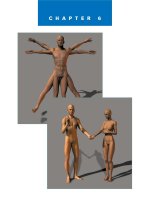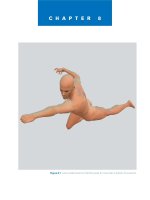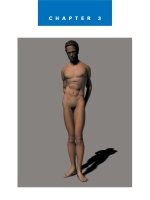Tài liệu Figure Drawing - Hand - Feed - Head pptx
Bạn đang xem bản rút gọn của tài liệu. Xem và tải ngay bản đầy đủ của tài liệu tại đây (2.15 MB, 24 trang )
CHAPTER 4
Hands, Feet, and Head
✎
51
S
ome areas of the figure are complex enough to warrant special atten-
tion by the figure artist because they are more difficult to draw than the
rest of the figure. These areas are the head, hands, and feet, and they
merit special attention from the artist who really wants to master figure draw-
ing. In this chapter we will take a closer look at each of these aspects of the
figure.
Hands
The human hand is probably the most versatile tool ever created. It is capable of
great strength, yet it can perform the most delicate operations. Its design allows
people to lift, hold, mold, rip, manipulate, caress, build, squeeze, sense, and
rearrange objects of all types. It can be used as a weapon or to give comfort. We
use our hands to greet others and even to communicate. The hand is the very def-
inition of the all-around instrument. With all that our hands can do, is it any won-
der that it is one of the more complex parts of the body to draw?
There is no quick and easy formula for drawing hands. To draw the hands well,
the artist must know the hands. He must take time to study and understand how
the hand works so that his drawings become more believable. Often the beginning
artist will be intimidated by the complexity of the hand and will avoid drawing it
by hiding it in a pocket or placing it behind the figure. Many otherwise good fig-
ure drawings will omit the hands, or they will just indicate the hands without any
real attempt to draw them correctly.
Part of the frustration that artists have in drawing the hand is that it is the most
flexible part of the body. It can assume almost infinite positions. It is full of mov-
ing parts. There are four fingers and a thumb, each jointed with no less than three
52
Figure Drawing with Virtual Models
joints. The fingers and thumb are
each capable of independent move-
ment. Because of this extreme flexi-
bility, there is not one view of the
hand that is adequate for learning
to draw it. It has to be studied
from many angles and in many
positions for the artist to truly
understand its overall nature.
Anatomy of the
Hand
Our hands are made up of 27
bones that can be split into three
groups. The bones of the wrist are
called the carpals. They are small
bones that work together to give
the wrist its flexibility. The wrist
itself is composed of eight separate
bones to allow for extreme move-
ment of the hand.
The wrist can move in almost any
direction in a half circle around the
end of the forearm. Unlike the
shoulder and the hips, which use a
single joint between two bones, the
joints of the wrist and the foot use
several bones. The bones of the
wrist and ankle are different in that
they need to be flexible yet sustain
prolonged pressure. The ankle, for
example, must remain locked in
place for extended periods while a
person is standing. The wrist must
lock in place when a person is
pushing with the hand. The many
bones that make up the wrist and
ankle are designed to withstand
extended pressure while remaining
flexible when needed. Figure 4.1
shows the bones of the hand.
The metacarpal bones run through
the palms of our hands. They are
longer and narrower than the
carpals and reach to the first
knuckles of the fingers and thumb.
The metacarpal bones are evident
on the back of the hand in adults
and elderly people, but are covered
by a thin layer of fat in babies and
children.
Figure 4.1 The carpal bones make the wrist flexible and strong.
53
Hands, Feet, and Head
If you flex and release your hand
you will see that the metacarpals
have quite a range of movement,
allowing for the hollow part of the
hand to conform to almost any
object that you might want to pick
up. Unlike the other joints of the
fingers that only bend in one direc-
tion, they can move in multiple
directions.
The bones in the fingers and
thumb are called phalanges. These
bones are on the back of the fin-
gers. The joints of the phalanges
only move in one direction, and
their range of motion is limited to
the palm side.
The bones of the hand are con-
trolled by a number of ligaments
that run across the back of the
hand for opening the hand and
through the palm for closing the
hand. Many of the muscles that
control the movement of the hand
are located in the forearms, not in
the hands themselves. The power-
ful muscles of the arm give the
hand such incredible strength with-
out the size associated with the
muscles needed for that strength.
Because of this, the hand itself can
be very small, yet still have a strong
grip that is capable of holding the
entire weight of the body.
The palm of the hand is hollow
with an indentation between the
joints of the fingers and the large
muscle of the thumb. This design
facilitates the operations of grasp-
ing and holding objects.
The back of the hand in an adult
has much less padding than the
palm, so the ligaments, bones, and
blood vessels are more evident.
Whereas the palm is somewhat
standard in its look from hand to
hand, the back of the hand can
have a big range in how it looks
due in large part to the veins that
crisscross it. The veins of the back
of the hand are unique to the indi-
vidual in much the same way that
individual fingerprints are unique.
One of the best sources for draw-
ing hands is to draw your own
hand. You can also try drawing
your friends’ hands. Figure 4.2
shows several hands drawn from
different angles. Try drawing lots of
hands until you start to feel com-
fortable with the subject. Think of
the fingers and thumb as tubes
connected by hinges. This should
help you to better visualize the
hand in three dimensions.
Figure 4.2 Draw hands from different angles.
54
Figure Drawing with Virtual Models
To better understand the hand, let’s
take a look at how it works. The
hand has two sides—the palm, or
grasping side, and the back, or
non-grasping side. Figure 4.3
shows the palm of the hand.
The palm is characterized by being
a concave surface surrounded by
muscle tissue, the largest of which
is the muscle that controls the
movement of the thumb. The fin-
gers are attached at the end of the
palm, and the thumb is attached to
the side. Tendons that extend
through the palm to the muscles of
the forearm control the movement
of the fingers. If you look carefully
at the underside of your wrist
while making a fist, you can see
the movement of these tendons.
The back of the hand is shown in
Figure 4.4. This part of the hand is
characterized by knuckles, ten-
dons, and veins, giving it a some-
times rough appearance.
Figure 4.3 The palm is the grasping side of the hand. Figure 4.4 You can see the tendons on the back of
the hand.
55
Hands, Feet, and Head
The knuckles of the hand follow
consecutive arcs that become more
and more pronounced from the
base of the hand outward, as
shown in Figure 4.5.
Notice that the second knuckle of
the thumb is along the arc of the
first knuckles of the fingers. When
constructing the hand, it is often
useful to draw in the arcs before
you rough in the fingers. This will
help to keep your hand unified
and the proportions right.
Figure 4.5 The knuckles of the hand follow arcs.
56
Figure Drawing with Virtual Models
The Foot
The foot is a marvel of engineering.
It is designed for holding the entire
weight of the body in balance.
Although it is relatively small com-
pared to the rest of the body, the
foot is designed to support the
body in a wide range of movement.
While most all other animals in the
animal kingdom walk on all fours,
man is the only land creature that
can balance walking on two legs
without the support of forepaws or
a tail.
The foot contains 26 bones, similar
to the hand’s 27, but the bones
of the foot are much larger and
heavier than those of the hand.
The largest bone of the foot is the
calcaneus that forms the heel. This
bone acts counter to the other
bones and is attached to the body’s
larges tendon, the Achilles tendon.
Just above the calcaneus bone is
the talus bone. The talus bone acts
as a pivot joint between the mas-
sive calcaneus bone and the front
bones of the foot. Figure 4.6 shows
the bones of the foot.
The mid foot contains the tarsal
bones. These bones form the arch
of the foot and act as weight dis-
tributors and shock absorbers.
Figure 4.6 The foot contains 26 bones.
The metatarsal bones are similar to
the hand’s metacarpal bones. They
are flexible joints that connect the
tarsal bones with the phalange
bones of the toes.
The phalange bones of the foot
comprise the bones of the toes.
There are 14 phalange bones—two
in the big toe and three in each of
the other toes.
The bottom of the foot is padded
with a layer of fat that acts as a
cushion for the foot. The plantar
fascia ligament holds the bones of
the arch together and lifts the arch.
A series of tendons runs along the
top of the foot up through the
ankle. These tendons are very evi-
dent in the foot, particularly when
the toes are lifted.
The Achilles tendon connects the
calf muscle with the calcaneus
bone on the heel of the foot. The
tendon forms the narrow ridge that
runs up the back of the foot.
The foot is basically wedge-shaped
from the side and with a concave
indentation of the arch on the
inside bottom. It is narrower at the
back than it is at the front. Like the
hand, a series of blood vessels
57
Hands, Feet, and Head
cross the upper foot, forming
ridges. Figure 4.7 shows some con-
struction drawings of the foot.
Try to draw the foot as many times
as you can. With the aid of a mir-
ror, you can get a good view of
your own foot to work from. In
addition, you can pose and draw
from the feet of your virtual mod-
els in Figure Artist. Figure 4.8
shows a close-up shot of a foot
from Figure Artist. Although not as
detailed as an actual foot, the mod-
els in Figure Artist are great for
learning proportion and construc-
tion of the foot.
Try isolating and drawing the foot
by itself so that you feel confident.
I remember talking with an artist
friend of mine who was trying to
get accepted at a major art gallery.
He said he brought his paintings
into the gallery and placed them
against the wall. The gallery owner
was talking with a customer and
didn’t pay much attention to him
for several minutes. Then, all at
once, he stopped talking and
walked over to my friend’s paint-
ings. He picked up one of his
paintings and asked if my friend
had painted it. My friend answered
that he had.
The gallery owner looked at my
friend and said, “You know how to
paint feet! You don’t know how
many artists I see who don’t know
how to paint feet.”
My friend was accepted into the
gallery.
Figure 4.7 Draw the foot from many different angles.
Figure 4.8 You can use the virtual feet in Figure Artist
as foot references.
Just because your feet are farthest
from your head and at the bottom
of the body does not mean that
they are not important. Figure 4.9
shows a more finished drawing of a
foot.
58
Figure Drawing with Virtual Models
Figure 4.9 Some drawings should look for the subtle detail in the shading of the foot.









